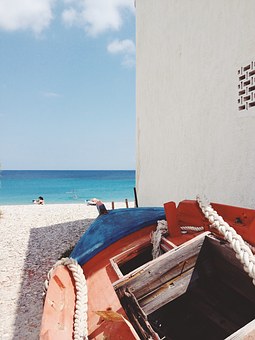Look Before You Launch -- things to check before your boat hits the water

Look Before You Launch -- things to check before your boat hits the water
Look Before You Launch things to check before your boat hits the water
Trailerable boats have it easy. For them it's a simple roll down the slipway until the boat floats off. Larger craft don't have that option. They must place their trust in the hands of others. Cash changes hands. Depending upon where you are, it can be lots of it. This is not something you want to be doing every day. Unless you're a boatyard, that is.
Boatyards and marinas prefer owners to be there when they crane in their boats. That way, as soon as they're properly afloat, the skipper can jump aboard and check for leaks. Only once he signals the thumbs-up will they remove the strops and allow the crane to trundle off to its next job.

Most sensible owners will check their boats as soon as they're hauled out, so will know if any major work is needed well ahead of the launch date. But no matter how confident we are that we have checked the various tasks off our lists, it's almost impossible to remain sanguine as the boat settles into the water. For this is a nervy moment.
My own method of panic limitation is to worry only about those jobs which are impossible to do once the boat is afloat. Anything that can be done later -- no matter how inconveniently -- is a grade two consideration which, if overlooked, will be irritating but redeemable.
At the top of the list must be the potential pathways which might allow water into the hull. Let's face it. Sinking is embarrassing. And expensive. Your friends will never let you forget it and neither will your insurers.
So, here's my pre-launch, anti-panic schedule.
Transducers: Apply silicone grease to the O-rings and fit the log transducer. Make sure the impeller spins without resistance. Yes, I know this can usually be done by withdrawing the transducer once the boat is afloat, but who wants to let in even a cupful of water with the bilges so dry?
Rudder: Check it works freely and that the bearings aren't binding. With cantilevered spade rudders, it's important to make sure that the neck bearing (where it emerges from the hull) isn't rotating with the stock. The proper arrangement is one where the bearing remains stationary and the stock turns inside it. Don't worry about a little bit of wear -- better some slack than a tight bearing.
On wheel steered boats, turn the wheel from hard over one way to hard over the other and make sure the rudder turns equally on both locks. If the steering mechanism has been worked on in any way -- perhaps wires replaced or push-rods stripped and serviced -- this is an essential check which can save you embarrassment on the way back from the launching bay. To see a boat fail to make a turn into its dock because the rudder will only turn a few degrees in that direction, might amuse the bystanders but is an inauspicious start to the season.
If there's a stuffing box on the stock, make sure it's lubricated and adjusted properly (see notes under Stern Glands below). Sealing O-rings should be replaced periodically, but you need to drop the rudder to do this so you might want to think about this earlier. Incidentally, always take the opportunity to replace them if you have to unship the rudder for any other reason.
Seacocks: These have a habit of seizing up during the lay-up period, so don't assume that just because they worked when you craned out they'll still be OK.
If the seacocks are of the bronze cone-valve variety (such as Blake's) hopefully they will have been greased and adjusted during your winter maintenance. It's common to see the adjustable compression plate either too slack or hardened down too tight. A good rule of thumb is that it should take the strength of two fingers to turn the lever.
Excellent though they normally are, ball valves are engineered to tight tolerances and it doesn't take much to jam them (it helps if they're worked regularly). Some years ago, just a few days after launching, we were joined on our first sail of the season by a friend and his new fianc. A sensitive lass, we were told, unsure whether she would actually like sailing. Take it easy, I was advised. Be gentle.
Unfortunately, motoring out of the harbour for a weekend at a local beauty spot, I discovered that the toilet outlet seacock was seized in the closed position. "All it needs is some gentle easing," I told them cheerfully. "It'll be fine by the time we anchor."
It wasn't fine. In my enthusiasm to fix the problem, I managed to shear the operating stem. Later I learned that the experience of perching on a bucket while the rest of us talked loudly in the cockpit was so traumatic for our newly betrothed lady that their future marriage became contingent on a cottage as far from the sea as possible. For them a landbound future beckoned and I had to pay to have my boat lifted out again for repairs.
Exterior grilles on inlet skin fittings should be cleared of any build-up of antifouling. The engine cooling water inlet is the most important as any restriction to the flow could lead to overheating. As you'll probably need the engine immediately, it's also not a bad idea to check the raw water supply right to the block: this will include the seacock, inlet strainer, water pump and hoses.
Stern gland: If of the conventional stuffing box type, these should be checked annually, adjusting or repacking as necessary -- and don't forget to fill the remote greaser with a water tolerant grease. It's tempting to over-tighten stern glands. Don't, or both the shaft and bearing surfaces will overheat and wear rapidly. Stuffing boxes are meant to leak; two or three of drips of water a minute being a useful indicator that you've got it just about right. Of course, this is impossible to judge with the boat ashore so you may need to adjust it later.
Face seal types such as the PSS and Deep Sea Seal, should be inspected annually. They depend on the thrust from the bellows to maintain the right degree of contact pressure, so it's worth checking the bellows' compression while you're about it. Assuming there's no damage and that the securing hose clips are in sound condition, they shouldn't need any other attention.
Lip seal glands wear gradually and should be replaced about every seven or so years, depending on how much use they've seen. Some call for a squirt of waterproof grease every 200 hours or annually, depending on which comes sooner. Shortly before the launch is an obvious opportunity.
Anodes: As one of the best investments you can make, it never pays to skimp on cathodic protection. If there's even the slightest chance that what's left of your anode won't make it through the season, dip your hand in your pocket and buy another.
And remember, with oval' anodes it's the fat end that points forward. As fishes have discovered, this is the best way to minimise drag and who are we to argue with them?
The cost of new attachment studs is minimal. If in doubt replace them.
Prop nut: Both the prop nut and its securing cotter pin (or tab washer) must be in good condition. The propeller itself might limp on for years with minor problems but if the nut dezincifies and splits you could lose the prop -- possibly the first time you go astern. You will find they don't float. So, checking the cotter pin is one of the last things I do.

Batteries and bilge pumps: Having taken your money, most boatyards want you clear of the launching bay almost as soon as you hit the water. That means you must start the engine. To have the gang glowering down on you as you grovel for the loan of a battery is not for the faint-hearted. Anyway, batteries should be charged regularly over the winter, if only to protect them from damage. To begin the season with them even partially flat makes no sense at all.
So, that's it. Nothing to it. I just hope I don't forget next year.
copyright Andrew Simpson
http://www.articlesbase.com/water-sports-articles/look-before-you-launch-things-to-check-before-your-boat-hits-the-water-3731074.html Choosing Between A Harbor Cruise Or A Speed Boat Cruise Lake Tahoe House Boat Rental – Get an Affordable Vacation Spot in Lake Tahoe Selecting Marinas In Florida For Docking Boats Kashmir Houseboats Vacation, Kashmir Houseboats, Houseboats in Dal Lake, Kashmir Tours, Honeymoon Packages in Kashmir, Houseboats in Dal Lake, Kettuvallam Houseboats Hydrogen fuel cell boat maiden voyage in Amsterdam The Necessity Of Boat Tarps Explore The Stunning Landscapes And Cultural Heritage Of Thailand On A Mekong River Boat Cruise Ontario Boating Accident Law Best Tricks In Providing Moisture Meter For Boat House Boat Hire In Australia Is a Fractional Boat for You? Sailing on Lake Windermere